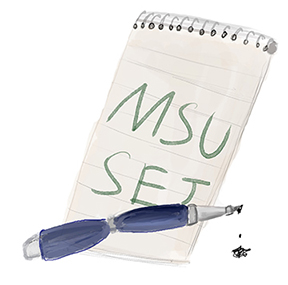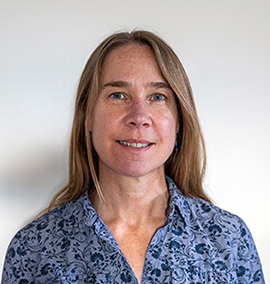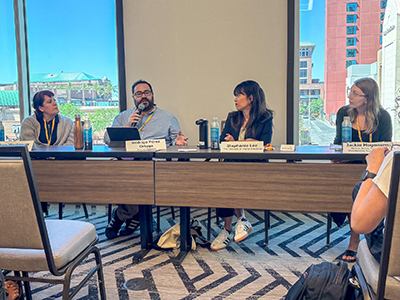 How to report on science controversies
How to report on science controversies
This is the 1st in a series of articles about reporting skills by Knight Center students who attended the 2025 Society of Environmental Journalists conference.
By RUTH THORNTON

Ruth Thornton
How can science journalists cover scientific controversies and scientists’ misconduct without decreasing the public’s trust in science itself?
A panel at this year’s Society of Environmental Journalists’ annual conference at Arizona State University discussed this gnarly problem.
The panel was moderated by Jackie Mogensen, a reporter with Mother Jones, and included panel members Stepanie Lee, a senior writer at the Chronicle of Higher Education, Rodrigo Pérez Ortega, a staff writer with Science magazine and Amy Westervelt, an investigative climate journalist and executive editor of Drilled.

Science controversies panel
Lee described her reporting about Brian Wansink, the now-discredited professor and researcher at Cornell University’s food lab who studied eating behaviors and food marketing.
“This was a lab at an Ivy League university with a lot of media attention and a lot of eye-catching and influential findings published in a lot of different journals,” Lee said.
Then, in 2016 or 2017, non-Cornell data scientists took a closer look at the numbers the studies reported, she said.
They “found a lot of very concerning red flags that somehow had not been noticed before, including straight-out impossible numbers,” Lee said.
She uncovered that the lab had been exaggerating and manipulating their calculations for years, she said.
“They were maniacally focused on getting media attention and buzz for their findings,” she said.
Lee said the faulty results impressed funders and pleased Cornell University.
And they were not detected by the journals.
“I talk about this story a lot because I think it illustrates what we think of as the checks and balances for the scientific ecosystem. Peer review and all these other safeguards that we think we have in place – often are not actually incentivized to catch big problems,” she said.
“It gives a sense of the ‘publish or perish’ mentality in academic science that is a big problem,” Lee said.
Westervelt said she focuses on accountability.
“I’m usually following the money, trying to figure out who’s funding the research and how much that might play into the results of the research,” she said.
Westervelt said she reported on the fossil fuel industry’s funding of research on carbon capture.
“University research in particular helped the industry really rebrand carbon capture from being an oil production hack to being a climate solution,” she said.
Mogensen said last year’s Pew Research Center’s survey of nearly 10,000 U.S. adults found that 76% of respondents said they have either “a great deal” or “a fair amount” of confidence in “scientists to act in the public’s best interest.”
That was slightly higher than the 73% of respondents who said they felt that way in 2023, but still below pre-pandemic levels, Mogensen said.
In April 2020, 87% of survey respondents said they had a great deal or fair amount of confidence in scientists, according to the Pew Research Center.
Lee said many people feel that scientists failed the public during the COVID-19 pandemic.
When asked what advice she gives science journalists when navigating controversial or complicated scientific problems, Lee advised to talk to experts, read many studies and see how the scientific consensus develops over time.
During the pandemic, the experts who were “loudest were not necessarily the most informed,” she said.
Ortega talked of his experience as a science journalist in Mexico when the pandemic hit.
“That was a real revelation — how little the public, but also journalists in general, knew about how science works,” he said.
He said it is important for journalists to get the scientific nuance right and to make sure they are talking to the right sources.
He gave one example where journalists talked to a famous scientist, who researched the origins of life, about the COVID-19 virus.
“He was happy to talk to them, because he’s great talking to journalists,” Ortega said, “but maybe he’s not the best source, right?”
Ortega said science journalists should clarify that they cover “scientists – people that do science,” he said, not “science in this big concept.”
“And they’re human, they have their own flaws, ideas, virtues,” he said.
Mogensen gave an example of a study that got a lot of headlines that claimed the COVID-19 virus came from dogs.
But an outside expert she consulted said the study had many problems. Instead of covering the story, she wrote about how other scientists said the study was bogus.
The panelists agreed that given recent changes in the Trump administration’s funding of science, maintaining transparency of funding is vital.
Westervelt said corporate funding does not necessarily equate to bad research.
“It’s not like some executive from BP is showing up in the lab and saying, ‘Cook the numbers, kid.’ That’s not how it works,” she said.
“It works by them choosing the things that they’re going to invest research money in, and then the solutions that they don’t like are just not being funded,” Westervelt said.
“Of course it’s going to tip the scales towards what industry wants,” she said.
Ortega advised science journalists to always ask for more time and words from their editor.
“You will need that to make a story fair. Nuance is key here,” he said. “You want the reader to finish your story and understand what really happened.”
